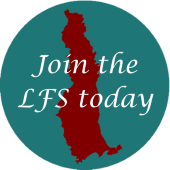We are always very keen to receive records of plants found on the island and invite you to enter your findings in the appropriate section in the LFS Logbook. To make your records really useful to us and to the Botanical Society of the British Isles please give as much information as possible.
- Species name – both common and scientific names if possible.
- Date of the record.
- Number of specimens present, and description: eg, in bud, in full flower, seed heads or leaves only.
- Precise location – unfortunately, vague comments like, “along the east side”, or “beyond the airfield” are not much help so please give as much detail as you can, with sketches or simple maps if possible.
- Photographs can be really helpful, especially if there is any doubt over the identification or the location of the plant.
- Please include your contact details so that we can get in touch if there are any further questions.
Example:
 Goldenrod Solidago virgaurea
Goldenrod Solidago virgaurea
28th September 2016
Approximately 20 plants in flower along the edge of the quarry terraces on the east side next to the Heligoland Bird Trap.
Most plants were about 30cm tall.
Found by Andrew Cleave This email address is being protected from spambots. You need JavaScript enabled to view it.
Can you help find some of Lundy's lost plants?
Many interesting plants have been recorded on Lundy in the last 100 years, but some have not been seen recently. They may just have been overlooked, or possibly have vanished altogether. If you can find any of the following species, please DO NOT pick them but instead, make a note of the precise location, draw a sketch map if possible, and, even better, take a photograph. Details can then be entered in the LFS logbook held in the Marisco Tavern.
For further information, or to report sightings, please contact This email address is being protected from spambots. You need JavaScript enabled to view it..
|
Moonwort Botrychium lunaria
A very small fern, usually about 10cm tall, which was last seen near Three-quarter Wall in the 1930s. It favours short turf, and is fully grown in June and July. Small-flowered Catchfly Silene gallica
Resembles a diminutive White Campion with tiny white or pale pink flowers. Usually in dry, sunny sites. Not seen since 1960s. |
Lanceolate Spleenwort Asplenium obovatum Recorded about 80 years ago, but no details were given about its location. It should be found on walls or sometimes in natural rock crevices. Beware confusion with Black Spleenwort which is quite common in places. Shepherd’s Cress Teesdalia nudicaulis
A small white-flowered plant similar to Shepherd’s Purse but with unequal petals (2 large and 2 small) and flowers in a compact head, usually open in April. Prefers dry open areas and very short turf or bare soil. Not seen since 1990s. White Horehound Marrubium vulgare
Used to grow in dry, sunny areas, such as around The Barn or in well-used gateways. Whorls of small white flowers are produced in July, and the leaves have a soft, downy texture. Host to the Horehound Plume Moth. Last seen in early 1980s. |
Autumn Ladies’ Tresses Spiranthes spiralis
A small, white-flowered and delicately-scented orchid which flowers late in the season, so look for this in August and September. It favours short grass and dry, sunny conditions, and has been reported near the Castle. Ivy Broomrape Orobanche hederae
One of a number of parasitic plants which are very similar; this, or a closely-related species, may have been recorded in recent years. Beware confusion with the dried-up flower spikes of Wall Pennywort Umbilicus rupestris. Could be present in the Millcombe area, or along Beach Road. |
Downloads of this information in PDF format is available at Lundy's Lost Plants 1, Lundy's Lost Plants 2 and Lundy's Lost Plants 3.
Text by Andrew Cleave
2019 species records
With a welcome increase in the number of fauna and flora records being entered in the LFS logbook, held on the island in the Marisco Tavern, the size of the Annual Report has grown in recent years. To help control the costs of printing and distribution we have changed the way these records are presented with the use of narrative reporting rather than long lists of species records. The detailed lists of records are nevertheless a valuable resource so, for many taxa, these have been made available to view on this website.
Insects
There are no articles in this category. If subcategories display on this page, they may have articles.
Latest news
Lundy weather station live feed
A live feed from the Lundy weather station, partly funded by the LFS, is now available in the resources section of this website, here.
New archaeology book published

A completely new and revised booklet on Lundy’s Archaeology has been published.
LFS Day Trip Cancelled
Unfortunatley, due to insufficient ticket sales to make the event viable, we have had to cancel our planned day trip to Lundy on 4 June. Existing ticket holders will be refunded shortly.
Subcategories







